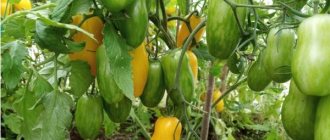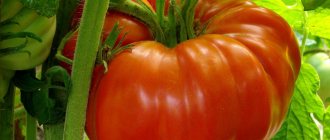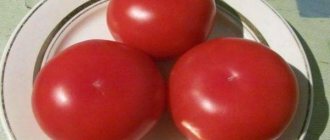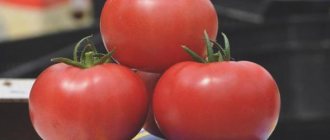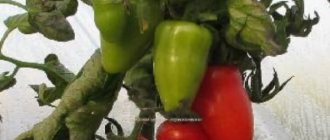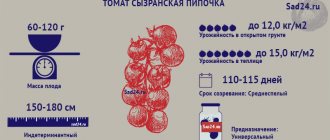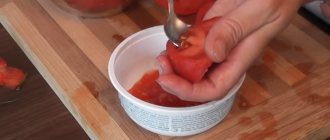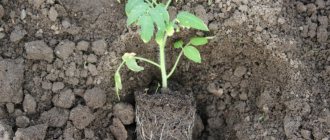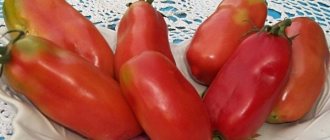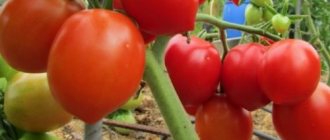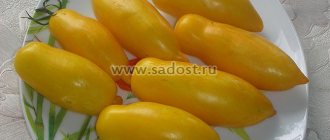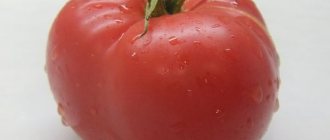There is a huge variety of tomato varieties. Among them, one can highlight a fruit with a beautiful shape and an interesting name - this is the Ballerina tomato.
| Height | Landing location | Ripening time | Fruit color | Fruit size | Origin | Fruit shape |
| short | Greenhouse, Open ground | Mid-season | Reds | Average | Hybrid | Plum-shaped or oval |
Tomato "Ballerina": description of the variety
| Variety name | Ballerina |
| general description | Early maturing determinate hybrid |
| Originator | Folk selection |
| Ripening period | 100-105 days |
| Form | Fruits are elongated, bullet-shaped |
| Color | Red |
| Average weight of tomatoes | 60-100 grams |
| Application | Universal |
| Productivity of the variety | 9 kg per square meter |
| Features of cultivation | Standard agricultural technology |
| Disease resistance | In rare cases, root rot may occur |
This is an early ripening hybrid; 100-105 days pass from the moment of planting seedlings to harvesting the first harvest. Has F1 hybrids of the same name. The bush is determinate, standard. Like many modern tomatoes, it resists fungal diseases and harmful insects well .
The growth of the bush is small, about 60 cm. It is intended for planting in open ground, but many grow tomatoes in greenhouse shelters.
Ripe fruits are red in color, very interesting in shape, elongated, bullet-shaped. The skin is matte and dense. The taste is pleasant, sweet and sour, well expressed.
The weight of tomatoes ranges from 60 to 100 g; at the first harvest they can reach 120 g . Number of chambers 4-5, dry matter content up to 6%, sugars 3%. The collected fruits can be stored for a long time and tolerate transportation well.
| Variety name | Fruit weight |
| Ballerina | 60-100 grams |
| f1 favorite | 115-140 grams |
| Tsar Peter | 130 grams |
| Peter the First | 30-250 grams |
| Black Moor | 50 grams |
| Apples in the snow | 50-70 grams |
| Samara | 85-100 grams |
| Sensei | 400 grams |
| Cranberries in sugar | 15 grams |
| Raspberry Viscount | 400-450 grams |
| The Tsar Bell | up to 800 grams |
Description of fruits
Let's consider the description of the fruits and the specifics of growing plants. Description of the variety cannot do without characteristics of the fruits. The shape of Ballerina resembles peppers; the weight of each ripe vegetable can reach 200 g. All fruits have a rich red color and high pulp density.
The fruits have a thin peel, which, however, does not crack during long-term transportation. Each tomato contains an average of four seed chambers and is characterized by high taste. In a dark and cool place, ripe vegetables can be stored without losing their quality for up to 2 months.
Characteristics
“Ballerina” is a representative of folk selection; it received state registration as a hybrid recommended for cultivation in unprotected soil in 2005. Since that time, it has been in steady demand among farmers and summer residents, due to its appearance and versatility of use .
This variety is more suitable for the southern regions and the middle zone, where the highest yield is noted. Astrakhan, Volgograd, Belgorod, Crimea and Kuban are optimal. In other southern regions it also produces a stable harvest. In the middle zone it is recommended to cover with film.
In the north of the country it grows only in heated greenhouses, but in cold regions the yield may fall and the taste of the fruit may deteriorate.
Ballerina tomatoes go well with other fresh vegetables and will serve as a decoration for any table. They make very tasty juice and puree. Due to the unique shape of the fruit, they will look great in home-made preserves and barrel pickles. Can be used to prepare lecho.
In open ground, up to 2 kg of tomatoes can be harvested from each bush, with a recommended planting density of 4-5 bushes per square meter. m, so it comes out to 9 kg. In greenhouse shelters, the yield is 20% higher and amounts to about 10 kg per square meter . This is not a record yield, but still quite decent for a short plant.
| Variety name | Productivity |
| Ballerina | 9 kg per square meter |
| Striped chocolate | 8 kg per square meter |
| Big Mama | 10 kg per square meter |
| Ultra early maturing f1 | 5 kg per square meter |
| Mystery | 20-22 kg per square meter |
| White filling | 8 kg per square meter |
| Alenka | 13-15 kg per square meter |
| F1 debut | 18.5-20 kg per square meter |
| Boni M | 14-16 kg per square meter |
| Room surprise | 2.5 kg per bush |
| Anyuta f1 | 12-13.5 kg per bush |
Reviews
Regina from Tuapse said: “The ballerina is a real godsend for making preparations for the winter. Tomatoes are compact and fit into any jar. They are then convenient to take out, the skin does not wrinkle or crack. They taste sweet, can be used in salads and eaten just like that. I liked the variety."
And here’s what Anna says: “I’ve been growing this variety for more than one year and am very pleased with the harvest. The tomatoes ripened in one fell swoop; 3 kilograms of fruit were collected from one bush. Well suited for making juices, purees, cutting into salads. But the main use is conservation. You can stew vegetable stew with tomatoes or add it to other dishes.”
Advantages and disadvantages
Among the main positive qualities of this hybrid are::
- unique graceful shape of the fruit;
- can be used as an ornamental plant;
- does not require formation;
- resistance to temperature changes;
- the ability to grow on a balcony in urban conditions;
- early ripeness;
- a strong trunk that does not require support.
Among the disadvantages are capriciousness regarding the composition of the soil, not very high yields and demands on fertilizing.
Features of cultivation
The plant is low-growing, the brush is densely covered with tomatoes. Can be used as an ornamental plant. It is also worth noting its early ripening and resistance to temperature changes. The trunk of the bush does not need garter, and the branches do not need supports, since the plant is strong, with good branches. Seeds are sown in March-early April, seedlings are planted at the age of 50-55 days.
Prefers light, nutritious soils. She loves complex feeding 4-5 times per season. Responds well to growth stimulants. Watering with warm water 2-3 times a week in the evening.
Landing
The best harvest can be expected with the seedling method of growing tomatoes, when everything starts with sowing seeds 50 - 60 days before the planned planting in the ground. It is recommended to carry out the first picking of plants at the stage of formation of two full-fledged leaves. In this case, the seedlings are transplanted into separate containers with a volume of 300 - 500 ml. This allows the root system to develop more and the stems to strengthen before transplanting to permanent soil.
When caring for tomatoes, there is no particular need for tying up and constantly pinching side shoots. Watering the bushes should be carried out with warm, settled water, at least every 4 to 7 days, depending on the degree of drying of the soil. Fertilizing with mullein solution or mineral complexes must be carried out at the flowering stage of the bushes and during the development of the fruits themselves.
Among the prerequisites for successful crop cultivation, it is worth highlighting regular loosening of the soil, which prevents the formation of earthen crusts. Cleaning of sprouting weeds also requires thoroughness. The work should be carried out by pulling out the roots so that new shoots do not appear after a while.
During the hottest summer days, it is important to mulch the soil - covering the soil with impermeable material that does not allow sunlight to pass through and effectively prevents excessive evaporation of moisture from the ground. Woven materials are not suitable for such work.
No more than 5 – 6 plants can be planted on 1 square meter of fertile land. If the soil is highly acidic, you should add sifted wood ash or lime to it, and then dig everything thoroughly.
After planting the seedlings in a permanent place, they continue to care for the plants. Proper regular care is the key to abundant yields and high-quality ripened tomatoes. Tomato seedlings need:
- Water regularly and loosen the soil after watering. Water the plants at least 2 times a week; after moistening, the soil is loosened to enrich it with oxygen. After watering, some gardeners advise laying mulch: it maintains the level of moisture in the ground, and when growing outdoors, it helps protect the roots from nighttime temperature changes;
- feed the seedlings with nitrogen and potassium fertilizers. Nitrogen supplements ensure good growth of green mass and development of the root system, and potassium fertilizers have a positive effect on the taste characteristics of fruits;
- carry out stepsoning. The main shoot is determined, and the remaining shoots formed are removed. Ballerina produces few shoots, so it is not necessary to often take stepson bushes.
READ MORE: Armenian cucumber description, growing, planting and care with photos
For gardeners who grow the variety in a greenhouse, the first harvest can be harvested from the end of June. Peak fruiting occurs in mid-summer. Tomatoes are harvested regularly; first of all, fully ripe fruits are removed from the branches. Green tomatoes are suitable for home ripening.
Ballerina stores well, so green tomatoes can be put in a cool place and left for several weeks. Under room conditions, it takes about a week for them to ripen.
Cultivation by seedling method is recommended. Seeds are sown 2 months before planting in open ground. At the stage of the second true leaf, the crops are dived. This is necessary so that the plant gains enough strength by the time it is transplanted to a permanent location.
Tomatoes do not require pinching or staking.
In general, there are no special features of growing this variety. The soil should be loosened and watered in a timely manner. It is best to do this in the evening after sunset, the water should be warm.
Tomatoes are fed 4-5 times per season. Using complex and growth-stimulating drugs. Up to 6 plants are planted per 1 m2.
The Ballerina hybrid is grown in seedlings. The time for planting seeds is determined from the date of planting in open ground and a greenhouse. Usually the seeds are planted in early March, so that by May the grown seedlings can be planted in open ground. Sow as follows:
- Fertile soil is poured into the container for seedlings and spilled with water;
- make grooves in the ground no more than 1 cm deep. When planting several rows in a container, the distance between the rows should be at least 3 cm;
- a grain is lowered into the grooves in increments of 2 cm from the previous one;
- sprinkle peat on top of the grains, but do not crush it. A film is stretched over the container and the container with the grains is left to germinate in a warm, well-lit room.
Ballerina has good germination rate, so seedlings will appear 6-9 days after planting. Plant picking is carried out in the second leaf phase, seedlings are picked once, more often there is no need. Plants develop moderately, without excessively elongating stems.
Transplantation into a greenhouse is carried out from mid-April; planting into a heated greenhouse can be done from the end of March. Since the cold resistance of the variety is insignificant, there is no need to rush into planting in open ground; the optimal time for planting tomato seedlings outside is after the May holidays for Central Russia. In the south, warming begins much earlier; there, plants are planted in the street soil from mid-spring.
Experts recommend growing Ballerina tomatoes, like many others, using the seedling method. Seeds need to be sown in several containers 2 months before the sprouts are planned to be transferred to a permanent location. As soon as the second leaf pecks, it is necessary to make a dive, which is necessary for the plant to get stronger. It is also recommended to harden the seedlings by periodically taking them outside.
The plants do not require unusual care, and the productivity is not affected by the absence of a garter and ridding the plant of stepsons. In order for the bushes to bear fruit, it is enough to loosen the soil in a timely manner and water the plant with warm, settled water - best in the evening.
The variety is resistant to a number of fungal diseases. However, plants can be affected by melon aphids or slugs, and there is also a high risk of developing root rot if you do not care properly.
In order to overcome this disease, you need:
- Mulch the soil.
- Loosen the ground under the bushes.
- Reduce the amount of watering.
One bush, properly cared for, can bring a farmer 10 kg of ripe and tasty Ballerina tomatoes. The variety is well suited for preparing preparations for the winter. Good aesthetic qualities allow the tomato to become a decoration for the dinner table, and its excellent taste makes it possible to cook tomatoes with various vegetables. You can also eat tomatoes fresh.
Among the positive qualities of the Ballerina tomato are the versatility of use and the unusual shape of the fruit.
Diseases and pests
"Ballerina" is immune to fungal diseases. In rare cases, root rot may occur. This disease is combated by loosening the soil, reducing watering and mulching.
also be wary of diseases associated with improper care . To avoid these troubles, you must follow the watering regime and regularly loosen the soil. Ventilation measures will also be effective if the plant is in a greenhouse.
Of the harmful insects, it is often damaged by melon aphids and thrips; the drug “Zubr” . In open ground, they are attacked by slugs; they are collected by hand, all tops and weeds are removed, and the ground is sprinkled with coarse sand and lime, creating a kind of barrier.
